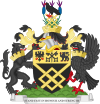Colliers Wood
Colliers Wood is an area in south London, England, in the London Borough of Merton. Colliers Wood station is served by the London Underground's Northern Line.
In July 2010 the first Barclays Cycle Superhighway opened, with a continuous bicycle lane known as CS7 linking Colliers Wood with the centre of London, specifically Southwark Bridge.
Wandle Park is near Colliers Wood Underground station. It is approximately 11 acres (45,000 m2). It is bounded to the south by Colliers Wood High Street, where there is an entrance, the River Wandle to the West, and Byegrove Road to the North. 51°25′07″N 0°10′48″W / 51.41861°N 0.18000°W
Colliers Wood United F.C. is a semi-professional football club based in Colliers Wood.
Colliers Wood shares its postcode district with Wimbledon, with postcode lookups returning this suburb name and some organisations insisting on its use. It merges into Merton Abbey.
History
- For a history of this part of the borough, see Merton.

Colliers Wood takes its name from a wood that stood to the east of Colliers Wood Road, approximately where Warren, Marlborough and Birdhurst Roads are now. Contemporary Ordnance Survey maps show that this wood remained at least until the 1870s but had been cleared for development by the mid-1890s.
It is home to 12th Century ruin Merton Priory, one of 38 places in the UK currently being considered by the Department of Culture, Media and Sport to go forward as British candidates for World Heritage status in 2011. Henry VI, the only king of England to be crowned outside of Westminster Abbey in the last 1,000 years, held his coronation ceremony at Merton Priory in 1437. Among those educated at the priory were Thomas Becket and Nicholas Breakspear, who was the only ever English Pope.
Close to Merton Priory is the market and heritage centre at Merton Abbey Mills, which is on the bank of the River Wandle. The Wandle was reputed to have more mills per mile than any other river in the world - 90 mills along its 11 mile length. William Morris, at the forefront of the Arts and Crafts Movement, relocated his dyeworks to Merton Abbey Mills, after determining that the water of the Wandle was suitable for dyeing. The complex, on 7 acres (28,000 m2), included several buildings and a dyeworks, and the various buildings were soon adapted for stained-glass, textile printing, and fabric- and carpet-weaving.[1]. The works closed in 1940. The site is now occupied by a large supermarket (originally a SavaCentre opened on 28 February 1989 with 107,430 sq ft (9,981 m2) of sales area, making it the largest hypermarket in the UK at the time of its opening).
The world's first public railway, the Surrey Iron Railway passed through Colliers Wood on its route from Croydon to Wandsworth, between 1803 and 1846.
Colliers Wood Tower
Colliers Wood is dominated by the "Colliers Wood Tower". Originally named the "Lyon Tower",[2] it was originally occupied as the headquarters of property company Ronald Lyon Holdings but has also been known as "The Vortex" and the "Brown & Root Tower". When being built, the tower reached the third storey before an error in construction was discovered and it was demolished to begin again.
It was voted the ugliest building in London in a 2006 BBC poll[3] and one of the 12 ugliest in the UK in a 2005 Channel 4 poll for its programme Demolition.[4] The same BBC poll quoted an architect working for Golfrate Property Management, the current owners, as saying the building was due a make-over and new lease of life, but this has yet to materialise.
Currently the ground and first floor windows and doors have been boarded up, and green netting has been attached all the way down each end to prevent falling debris causing injury to passers by.
Demolition of the adjacent spiral car park began in April 2010, but due to complications with an electrical substation was halted soon after, with half the car park still standing. By June 2011 it was eventually demolished entirely.
-
The Colliers Wood Tower
-
The Colliers Wood Tower - unoccupied
-
River Wandle with the Tower behind
References
- ^ Parry, William Morris, p. 57
- ^ Telegraph.co.uk - Obituary of Ronald Lyon
- ^ BBC Poll - Most Hated Building
- ^ Channel4.com - Demolition
http://www.morrissociety.org/JWMS/SP00.13.4.Goodman.pdf





